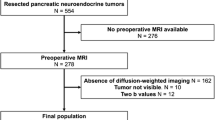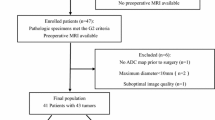Abstract
Purpose
To investigate the diagnostic performance of the minimal apparent diffusion coefficient (ADCmin) to distinguish between pancreatic neuroendocrine tumors (Pan-NETs) with low and high Ki-67 proliferation index values and to evaluate the relationship between ADCmin and the Ki-67 proliferation index.
Methods
Pre-operative magnetic resonance imaging data and postoperative Ki-67 proliferation index data of 42 patients with primary neuroendocrine tumor of the pancreas from November 2014 to March 2021 were included in this retrospective study. According to the Ki-67 proliferation index value, Pan-NETs were divided into a high-expression group (Ki-67 ≥ 10%, n = 17) and low-expression group (Ki-67 < 10%, n = 25), and mean ADC (ADCmean) and ADCmin values were compared between groups using receiver operating characteristic (ROC) curves to evaluate the performance of ADCmean and ADCmin in judging the expression level of Ki-67 proliferation index. The relationship between ADCmin and the Ki-67 proliferation index was also evaluated.
Results
The ADCmin was significantly higher in the low-expression group (Z = − 3.537, p < 0.01). The area under the ROC curve (AUC) for ADCmin was 0.825, which was higher than that for ADCmean (0.781). Using 1.32 × 10–3 mm2/s as the optimal discriminating threshold, the sensitivity, specificity, accuracy, and positive and negative predictive values of the two groups were 80%, 88.2%, 83.3%, 90%, and 75%, respectively. The ADCmin of Pan-NETs showed a significant negative correlation with the Ki-67 proliferation index (rs = − 0.634, p < 0.001).
Conclusion
The ADCmin is a potential imaging biomarker, which may be helpful for non-invasive preoperative prediction of the Ki-67 proliferation index of Pan-NETs and the subsequent planning of appropriate treatment.







Similar content being viewed by others
References
Nagtegaal ID, Odze RD, Klimstra D, Paradis V, Rugge M, Schirmacher P, Washington KM, Carneiro F, Cree IA. The 2019 WHO classification of tumours of the digestive system. Histopathology. 2020;76(2):182–8. https://doi.org/10.1111/his.13975.
Pavel M, Öberg K, Falconi M, Krenning EP, Sundin A, Perren A, Berruti A. Gastroenteropancreatic neuroendocrine neoplasms: ESMO Clinical Practice Guidelines for diagnosis, treatment and follow-up. Ann Oncol. 2020;31(7):844–60. https://doi.org/10.1016/j.annonc.2020.03.304.
**anwang L, Lei H, Hong L, Juan D, Shenglin L, Caiqiang X, Yan H, Junlin Z. Apparent diffusion coefficient to evaluate adult intracranial ependymomas: relationship to Ki-67 proliferation index. J Neuroimaging. 2021;31(1):132–6. https://doi.org/10.1111/jon.12789.
Zhao S, Guo W, Tan R, Chen P, Li Z, Sun F, Shao G. Correlation between minimum apparent diffusion coefficient values and the histological grade of breast invasive ductal carcinoma. Oncol Lett. 2018;15(5):8134–40. https://doi.org/10.3892/ol.2018.8343.
Zhang J, Chen X, Chen D, Wang Z, Li S, Zhu W. Grading and proliferation assessment of diffuse astrocytic tumors with monoexponential, biexponential, and stretched-exponential diffusion-weighted imaging and diffusion kurtosis imaging. Eur J Radiol. 2018;109:188–95. https://doi.org/10.1016/j.ejrad.2018.11.003.
Murakami R, Hirai T, Kitajima M, Fukuoka H, Toya R, Nakamura H, Kuratsu J, Yamashita Y. Magnetic resonance imaging of pilocytic astrocytomas: usefulness of the minimum apparent diffusion coefficient (ADC) value for differentiation from high-grade gliomas. Acta Radiol. 2008;49(4):462–7. https://doi.org/10.1080/02841850801918555.
Matondang S, Ekawati A, Andrijono TH, Prihartono J. Minimal apparent diffusion coefficient value of the solid component to differentiate borderline and malignant ovarian epithelial tumours: a preliminary report. Pol J Radiol. 2020;85:e250–3. https://doi.org/10.5114/pjr.2020.95921.
Pereira JA, Rosado E, Bali M, Metens T, Chao SL. Pancreatic neuroendocrine tumors: correlation between histogram analysis of apparent diffusion coefficient maps and tumor grade. Abdom Imaging. 2015;40(8):3122–8. https://doi.org/10.1007/s00261-015-0524-7.
Lee S, Kim SH, Hwang JA, Lee JE, Ha SY. Pre-operative ADC predicts early recurrence of HCC after curative resection. Eur Radiol. 2019;29(2):1003–12. https://doi.org/10.1007/s00330-018-5642-5.
Kim JH, Eun HW, Kim YJ, Han JK, Choi BI. Staging accuracy of MR for pancreatic neuroendocrine tumor and imaging findings according to the tumor grade. Abdom Imaging. 2013;38(5):1106–14. https://doi.org/10.1007/s00261-013-0011-y.
Gupta PK, Awasthi R, Singh S, Behari S, Maria Das KJ, Gupta RK, Kumar S. Value of minimum apparent diffusion coefficient on magnetic resonance imaging as a biomarker for predicting progression of disease following surgery and radiotherapy in glial tumors from a tertiary care center in Northern India. J Neurosci Rural Pract. 2017;8(2):185–93. https://doi.org/10.4103/0976-3147.203823.
Sun X, Kaufman PD. Ki-67: more than a proliferation marker. Chromosoma. 2018;127(2):175–86. https://doi.org/10.1007/s00412-018-0659-8.
Zhao S, Shao G, Chen P, Li L, Yang Y, Zhao X, Guo W. Diagnostic performance of minimum apparent diffusion coefficient value in differentiating the invasive breast cancer and ductal carcinoma in situ. J Cancer Res Ther. 2019;15(4):871–5. https://doi.org/10.4103/jcrt.JCRT_607_18.
Hirano M, Satake H, Ishigaki S, Ikeda M, Kawai H, Naganawa S. Diffusion-weighted imaging of breast masses: comparison of diagnostic performance using various apparent diffusion coefficient parameters. AJR Am J Roentgenol. 2012;198(3):717–22. https://doi.org/10.2214/ajr.11.7093.
Scarpa A, Mantovani W, Capelli P, Beghelli S, Boninsegna L, Bettini R, Panzuto F, Pederzoli P, delle Fave G, Falconi M. Pancreatic endocrine tumors: improved TNM staging and histopathological grading permit a clinically efficient prognostic stratification of patients. Modern Pathol. 2010;23(6):824–33. https://doi.org/10.1038/modpathol.2010.58.
Kim KW, Krajewski KM, Nishino M, Jagannathan JP, Shinagare AB, Tirumani SH, Ramaiya NH. Update on the management of gastroenteropancreatic neuroendocrine tumors with emphasis on the role of imaging. AJR Am J Roentgenol. 2013;201(4):811–24. https://doi.org/10.2214/ajr.12.10240.
Bammer R. Basic principles of diffusion-weighted imaging. Eur J Radiol. 2003;45(3):169–84. https://doi.org/10.1016/s0720-048x(02)00303-0.
Wang Y, Chen ZE, Yaghmai V, Nikolaidis P, McCarthy RJ, Merrick L, Miller FH. Diffusion-weighted MR imaging in pancreatic endocrine tumors correlated with histopathologic characteristics. J Magn Reson Imaging. 2011;33(5):1071–9. https://doi.org/10.1002/jmri.22541.
Lotfalizadeh E, Ronot M, Wagner M, Cros J, Couvelard A, Vullierme MP, Allaham W, Hentic O, Ruzniewski P, Vilgrain V. Prediction of pancreatic neuroendocrine tumour grade with MR imaging features: added value of diffusion-weighted imaging. Eur Radiol. 2017;27(4):1748–59. https://doi.org/10.1007/s00330-016-4539-4.
Kang Y, Choi SH, Kim YJ, Kim KG, Sohn CH, Kim JH, Yun TJ, Chang KH. Gliomas: Histogram analysis of apparent diffusion coefficient maps with standard- or high-b-value diffusion-weighted MR imaging–correlation with tumor grade. Radiology. 2011;261(3):882–90. https://doi.org/10.1148/radiol.11110686.
Harimoto N, Araki K, Hoshino K, Muranushi R, Hagiwara K, Ishii N, Tsukagoshi M, Igarashi T, Watanabe A, Kubo N, Tomonaga H, Higuchi T, Tsushima Y, Ikota H, Shirabe K. Diffusion-weighted mri predicts lymph node metastasis and tumor aggressiveness in resectable pancreatic neuroendocrine tumors. World J Surg. 2020;44(12):4136–41. https://doi.org/10.1007/s00268-020-05736-3.
Surov A, Meyer HJ, Wienke A. Correlation between minimum apparent diffusion coefficient (ADC(min)) and tumor cellularity: a meta-analysis. Anticancer Res. 2017;37(7):3807–10. https://doi.org/10.21873/anticanres.11758.
Ren H, Mori N, Hamada S, Takasawa C, Mugikura S, Masamune A, Takase K. Effective apparent diffusion coefficient parameters for differentiation between mass-forming autoimmune pancreatitis and pancreatic ductal adenocarcinoma. Abdom Radiol (New York). 2021;46(4):1640–7. https://doi.org/10.1007/s00261-020-02795-x.
Kulali F, Semiz-Oysu A, Demir M, Segmen-Yilmaz M, Bukte Y. Role of diffusion-weighted MR imaging in predicting the grade of nonfunctional pancreatic neuroendocrine tumors. Diagn Interv Imaging. 2018;99(5):301–9. https://doi.org/10.1016/j.diii.2017.10.012.
Baur AD, Pavel M, Prasad V, Denecke T. Diagnostic imaging of pancreatic neuroendocrine neoplasms (pNEN): tumor detection, staging, prognosis, and response to treatment. Acta Radiol. 2016;57(3):260–70. https://doi.org/10.1177/0284185115579932.
Funding
This study was supported by grants from the National Natural Science Foundation of China (81772006).
Author information
Authors and Affiliations
Contributions
YX conceptualization, methodology, software, writing—original draft. SZ methodology, writing—original draft. XL resources, investigation, revision. XH statistical analysis. QZ methodology, validation. YL visualization, software. QN pathological interpretation. JZ conceptualization, methodology, supervision, funding acquisition. Conceptualization YX and JZ. Writing—original draft preparation YX and SZ. Writing—review and editing QZ, YL, XL, PT, LX and JZ. Statistical analysis XH. Pathological interpretation QN. All authors have read and agreed to the published version of the manuscript.
Corresponding author
Ethics declarations
Conflict of interest
The authors declare that they have no conflict of interest.
Ethical approval
All procedures performed in studies involving human participants were in accordance with the ethical standards of the institutional research committee and with the 1964 Helsinki declaration and its later amendments or comparable ethical standards.
Informed consent
The study was approved by the Institutional Review Board, and informed consent was waived due to retrospective analysis of the study.
Additional information
Publisher's Note
Springer Nature remains neutral with regard to jurisdictional claims in published maps and institutional affiliations.
Yi**g **e and Shipeng Zhang contributed equally to this work.
About this article
Cite this article
**e, Y., Zhang, S., Liu, X. et al. Minimal apparent diffusion coefficient in predicting the Ki-67 proliferation index of pancreatic neuroendocrine tumors. Jpn J Radiol 40, 823–830 (2022). https://doi.org/10.1007/s11604-022-01262-5
Received:
Accepted:
Published:
Issue Date:
DOI: https://doi.org/10.1007/s11604-022-01262-5




